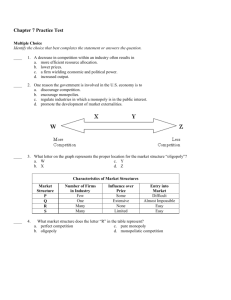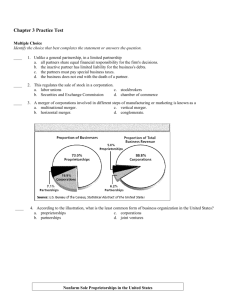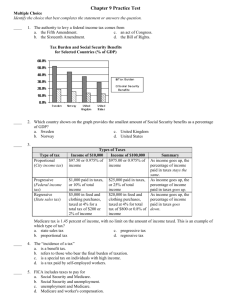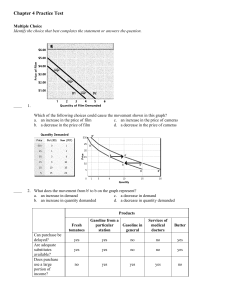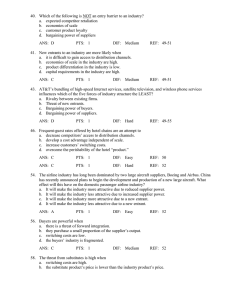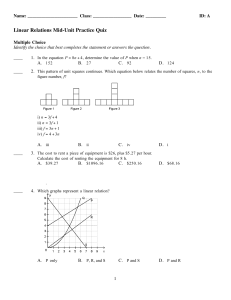Economics Practice Test: Supply, Production, and Costs
advertisement
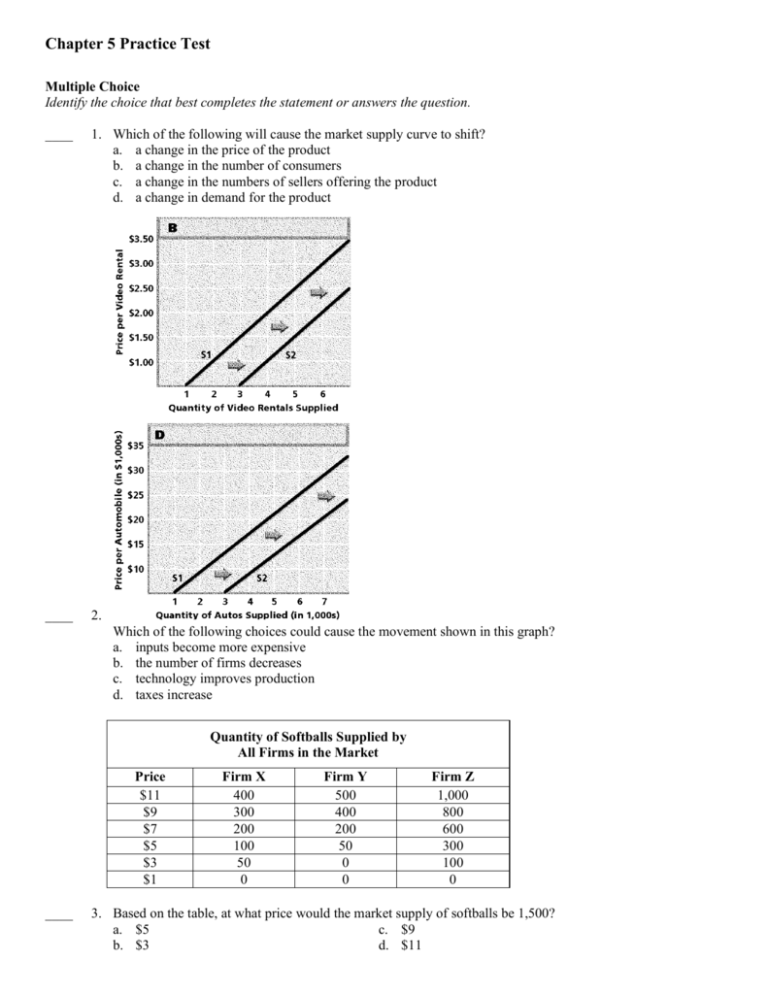
Chapter 5 Practice Test Multiple Choice Identify the choice that best completes the statement or answers the question. ____ 1. Which of the following will cause the market supply curve to shift? a. a change in the price of the product b. a change in the number of consumers c. a change in the numbers of sellers offering the product d. a change in demand for the product ____ 2. Which of the following choices could cause the movement shown in this graph? a. inputs become more expensive b. the number of firms decreases c. technology improves production d. taxes increase Quantity of Softballs Supplied by All Firms in the Market Price $11 $9 $7 $5 $3 $1 ____ Firm X 400 300 200 100 50 0 Firm Y 500 400 200 50 0 0 Firm Z 1,000 800 600 300 100 0 3. Based on the table, at what price would the market supply of softballs be 1,500? a. $5 c. $9 b. $3 d. $11 Production Schedule Number of Workers 0 1 2 3 4 5 6 7 8 9 10 11 12 Costs Total Product Marginal Product* Total Fixed Costs Total Variable Costs Total Costs Marginal Costs 0 7 20 38 62 90 110 129 138 144 148 145 135 0 7 13 18 24 28 20 19 9 6 4 –3 –10 $50 50 50 50 50 50 50 50 50 50 50 50 50 $0 90 180 270 360 450 540 630 720 810 900 990 1,080 $50 140 230 320 410 500 590 680 770 860 950 1,040 1,130 -$12.86 6.92 5.00 3.75 3.21 4.50 4.74 10.00 15.00 22.50 --- *All figures in terms of output per day. ____ 4. Based on the table, what is the variable cost of the third worker? a. $270 c. $90 b. $5.00 d. $320 ____ 5. When producers offer fewer products for sale at each and every price, a. the supply curve has shifted to the right. b. the supply curve has shifted to the left. c. the price per unit decreases. d. they expect subsidies. ____ 6. What economic principle does the graph illustrate? a. law of supply b. law of diminishing marginal utility c. law of diminishing returns d. law of demand Production Schedule ____ Number of Total Marginal Workers Product Product* 0 0 0 1 7 7 2 20 13 3 38 18 4 62 24 5 90 28 6 110 20 7 129 19 8 138 9 9 144 6 10 148 4 11 145 –3 12 135 –10 *All figures in terms of output per day. 7. In this production schedule, production Stage III begins with the addition of which numbered worker? a. 10 c. 8 b. 6 d. 11 Production Schedule Number of Workers Total Product Marginal Product* 0 0 0 1 7 7 2 20 13 3 38 18 4 62 24 5 90 28 6 110 20 7 129 19 8 138 9 9 144 6 10 148 4 11 145 –3 12 135 –10 *All figures in terms of output per day. Costs Revenues Profit Total Fixed Costs Total Variable Costs Total Costs Marginal Costs Total Revenue Marginal Revenue Total Profit $50 50 50 50 50 50 50 50 50 50 50 50 50 $0 90 180 270 360 450 540 630 720 810 900 990 1,080 $50 140 230 320 410 500 590 680 770 860 950 1,040 1,130 -$12.86 6.92 5.00 3.75 3.21 4.50 4.74 10.00 15.00 22.50 --- $0 105 300 570 930 1,350 1,650 1,935 2,070 2,160 2,220 2,175 2,025 -$15 15 15 15 15 15 15 15 15 15 15 15 –$50 –35 70 250 520 850 1,060 1,210 1,300 1,300 1,270 1,135 895 ____ 8. According to the table, the company must hire at least how many workers to earn a profit? a. 1 c. 3 b. 2 d. 4 ____ 9. In the table, how much extra revenue does the company generate by producing and selling one additional unit of output? a. $90 c. $15 b. $13 d. $50 Chapter 5 Practice Test Answer Section 1. ANS: REF: 2. ANS: REF: 3. ANS: REF: 4. ANS: REF: 5. ANS: REF: 6. ANS: REF: 7. ANS: REF: 8. ANS: REF: 9. ANS: REF: C PTS: 1 DIF: Average Learn more about this question in Economics Principles and Practices, pages 118-121. C PTS: 1 DIF: Challenging Learn more about this question in Economics Principles and Practices, page 119. C PTS: 1 DIF: Average Learn more about this question in Economics Principles and Practices, page 117. C PTS: 1 DIF: Average Learn more about this question in Economics Principles and Practices, page 132. B PTS: 1 DIF: Average Learn more about this question in Economics Principles and Practices, page 118. C PTS: 1 DIF: Easy Learn more about this question in Economics Principles and Practices, pages 128-130. D PTS: 1 DIF: Average Learn more about this question in Economics Principles and Practices, pages 128-130. B PTS: 1 DIF: Easy Learn more about this question in Economics Principles and Practices, pages 134-135. C PTS: 1 DIF: Average Learn more about this question in Economics Principles and Practices, page 136.


